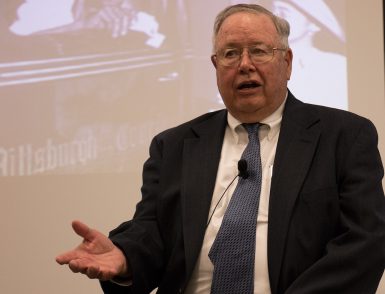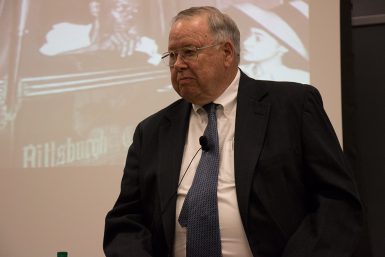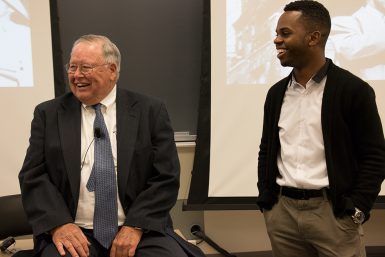Washburn describes black press’ WWII Double V campaign

Between constant FBI harassment and surveillance, black reporters in the first half of the 20th century had their jobs as advocates for the black community cut out for them.
Patrick Washburn, professor emeritus at Ohio University and one of the nation’s leading researchers of the black press, spoke with students in Ernie Pyle Hall on Monday night about how black newspapers toppled the pillars of institutional racism one at a time — and why their success has, until recently, been forgotten.
“Most people haven’t read this kind of thing or heard this type of thing,” Washburn said. He hadn’t heard of a single black newspaper himself until he started researching the topic as a part of his doctoral dissertation in mass communications at Indiana University in 1984, where he also had earned a master’s degree in journalism in 1973.
After several requests for several thousands of documents from the federal government and interviews with black reporters, Washburn found that papers like the Pittsburgh Courier and the Chicago Defender not only advocated for radical changes in the American racial order, but turned a profit at the same time.
Washburn told students about the Double V Campaign, which was launched by the Courier in February of 1942 as America entered World War II. The V stands for victory, and its goal was for America to win the war against the Germans, Japanese and Italians, and against institutional racism at home.
“In the South, you still had blacks being lynched, you still had blacks and whites paying poll taxes, except blacks couldn’t afford the poll tax,” Washburn said. “So they started saying ‘Let’s have a double victory.’”

The campaign spread to several other newspapers, and it became a national sensation. Celebrities took pictures holding up two Vs. Women began sewing Vs into their clothing. Some fashioned their hair into the shape of Vs. By the summer of that year, 200,000 people joined the Double V movement by sending the Pittsburgh Courier five cents.
“As the black press was pointing out this inequality and that inequality, the government started to get nervous,” Washburn said. “They were worried because until August of 1942, the government wasn’t sure if they could win (the war) without 10 percent of the population.”
Blacks made up 10 percent of the population of the United States. But it wasn’t easy for black Americans to directly help the war effort. Black Americans who enlisted found the Coast Guard, the Marine Corps and the Army Air Corps outright refused black recruits.
Blacks had two options: Serve in the Navy as cooks or join the Army. But the Army limited its black forces at only 10 percent, proportional to the U.S. black population. For every nine white soldiers enlisted, the Army could enlist one black recruit.
Initially, blacks weren’t allowed to donate blood. When this later changed, the donated blood could be given only to a black person.
The FBI started putting pressure on the black press, Washburn said. Agents sat outside the offices of the Pittsburgh Courier and monitored everyone who came and went. Agents routinely threatened editors with investigations and legal action to silence them. More subtly, the FBI had the newspaper delivered to their offices to send the message that they were keeping an eye on them.
But by the end of the war, the Pittsburgh Courier circulation almost had doubled, from 190,000 to 350,000, and the White House press corps welcomed its first black journalist. Businesses were opting to advertise in black newspapers, which was virtually unheard of before the start of the World War II.
Washburn said a columnist for the Pittsburgh Courier wrote in 1942 that “When the war ends, the colored American will be better off financially, spiritually and economically. War may be hell for some, but it works well to open up the portals of heaven for us.”

“And that’s what happened in World War II,” Washburn said. “Blacks got a lot of rights that they didn’t have before.”
Washburn’s lecture was the result of junior Daion Morton’s curiosity. A student in J418 Footsteps of Ernie Pyle, a class that examines World War II from a journalist’s perspective, Morton contacted Washburn after talking with associate professor Mike Conway about the lack of information on journalists of color in WWII.
Washburn said he agrees that there’s not enough research on the topic, but he also said that’s changing.
“The things I’ve seen in mass communications in the past 20 years is that there’s a lot more being written about blacks and a lot more being written about women,” Washburn said. “And now those are becoming topics that are written about.”

